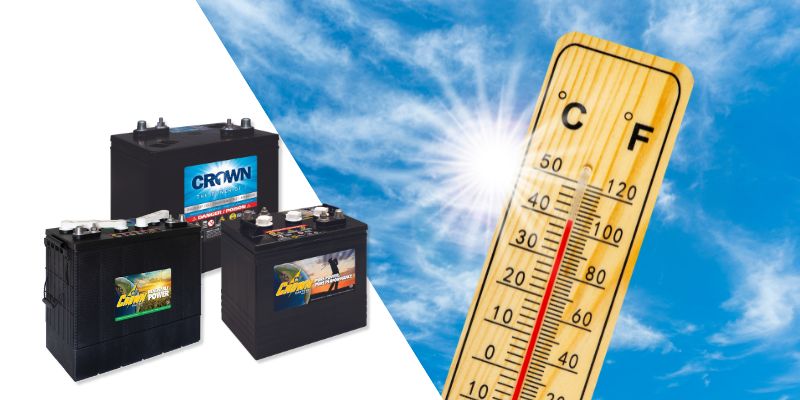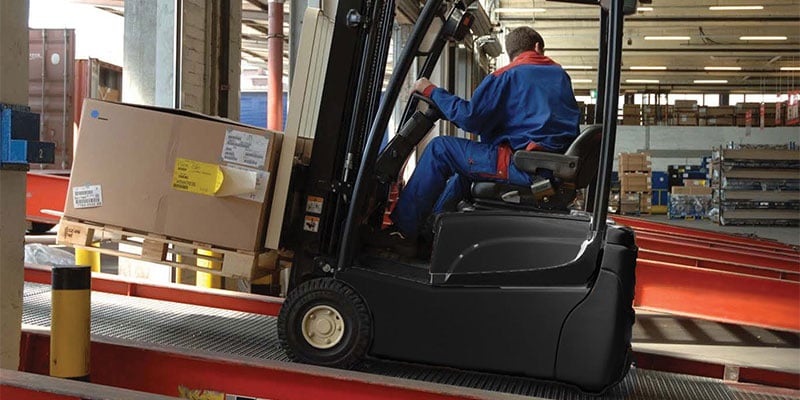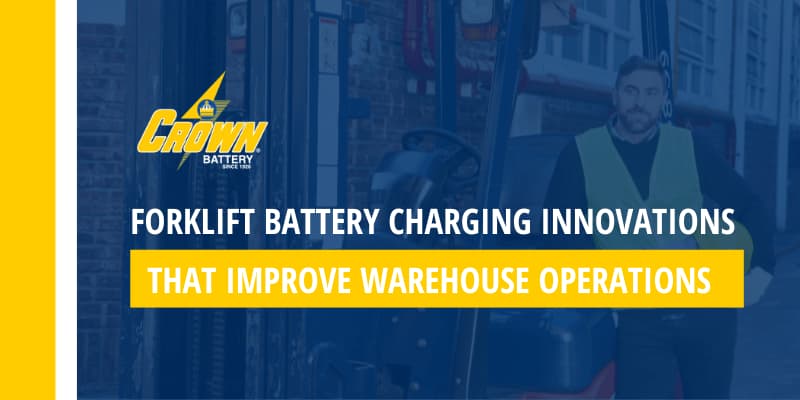Heat kills batteries – but it doesn’t have to, once you read this.
Whether you’re powering a home, forklift, golf cart, or boat…
… simple heat management drastically prolongs battery life, improves operational efficiency, and ensures you don’t lose power when needed.
And in this article, you’ll discover a practical strategy that protects your batteries and:
- Extends Battery Lifespan - improving ROI and reducing replacement costs.
- Improves Performance: Batteries operated in their optimal temperature range deliver power more consistently and efficiently.
- Reduces Downtime: By preventing, identifying, and addressing heat-related issues before they cause severe damage, you’ll decrease battery downtime and improve overall operational effectiveness.
But before we get into the nuts and bolts of protecting your batteries from heat, it’s critical to understand how temperature affects batteries.
Heat matters: Every 15°F average operating temperature over 77°F (25°C) slashes battery lifespan in half.
A battery's performance and lifespan are significantly affected by its operating environment.
And all batteries have an optimal operating temperature range, whether recyclable lead-acid or absorbent gel mat (AGM), lithium-ion, nickel-cadmium, or another type.
When batteries operate at higher temperatures, they can charge and discharge faster. But heat degrades batteries’ internal components and slashes lifespan. High battery temperatures also decrease capacity and efficiency.
And this phenomenon happens in all battery applications, from off-grid renewable energy systems to motive power and boating.
Larger batteries generally operate best between 50 – 85°F (10 – 29°C).
And heat is particularly problematic when batteries operate in demanding conditions with heavy outdoor use (which generates internal heat).
The solution: Temperature management
Ensuring moderate temperatures is critical, especially for stationary battery systems and renewable energy applications governed by the National Electrical Code (NEC) in the United States (or similar organizations in other countries).
NEC regulations stipulate temperature ranges for safe operation and recommendations for enclosures, ventilation, smoke detectors, and other requirements. Together, these best practices minimize the likelihood of overheating and its hazards.
Here’s how to beat the heat – and optimize ambient and battery temperatures:
Strategies for managing heat exposure vary depending on the battery type and application, but the following steps are always beneficial:
1) Ensure Appropriate Battery Housing:
For forklifts, golf carts, and other motive power applications:
- Install charging stations in cool, well-ventilated locations.
- Avoid direct sunlight – it’s too hot in the summer, and it heats batteries unevenly year-round.
- Ensure adequate ventilation: Check for sufficient ventilation to dissipate heat if batteries are stored or charged in a confined space.
For renewable energy applications like home batteries and off-grid systems, the location and design of battery housing can significantly affect heat exposure. For near-zero maintenance AGM batteries, for instance, storage in a battery box in the home can work well.
In harsher climates, battery banks may require more comprehensive solutions. Consider the Plateau Solar Project, an off-grid solar home project for Navajo families in the Four Corners region near Arizona. In these desert conditions, temperatures fluctuate between -14°F – 86°F (-10°C – 30°C) – a nightmare for batteries. Mark Snyder Electric designed and installed an innovative Enertopia Multi-Purpose Utility Structure (EMPUS) for this project. The patent-pending 4x8 foot (1.2 x 2.4 meter) modular unit houses batteries and vital electronic components in a climate-controlled environment, protecting them from harsh weather and extreme temperatures.
Be sure protective enclosures are well-insulated and ventilated to avoid trapping heat. And consider fans or climate control options to keep temperatures within the optimal range.
2) Manage Charging Practices:
Charging generates heat, so avoiding overcharging and rapid charging is vital when possible. Smart charging systems, which can regulate the charge rate based on battery temperature and charge state, can be beneficial in this regard.
Adhering to the manufacturer’s recommended guidelines can help prevent overcharging, a significant cause of battery damage.
3) Regular Inspection and Maintenance (even for AGM and Lithium-Ion):
Routine maintenance:
- Saves money by improving lifespan.
- Keeps batteries working optimally, so they aren’t generating excessive heat.
- Reveals signs of heat damage early before they lead to severe problems – such as swelling in the battery case or corrosion.
Now, your battery manual should walk you through maintenance and inspection.
And for an easy-to-follow, hands-on overview of battery maintenance and safety, check out our complimentary “Safety First” maintenance guides.
4) Consider a Battery Management System (BMS):
Where recommended, BMS serves as a first line of defense against potential heat-related issues.
BMS is a mini-computer with battery sensors. BMS consistently monitors critical data like temperature, voltage, and current – and provides real-time feedback. Thus, it gives real-time feedback on battery performance, ensuring your system operates within optimal parameters.
Because BMS gives you an early warning about ambient and battery temperature, it can mitigate or prevent overheating and other problems that kill batteries.
For instance, if the BMS detects battery overheating, it can take corrective action --from adjusting the charging rate to completely disconnecting the battery, ensuring its longevity, and mitigating battery failure and safety hazards.
5) Choose reliable batteries optimized for your needs and application:
You’ll want batteries designed to withstand higher temperatures. For instance, Crown’s CRP Monobloc series is robotically welded and field-tested/studied in more than 1,000 locations, including the Plateau Solar Project. This testing ensures high lifespan, durability, and performance.
All battery technologies have pros and cons – including ours. Let’s briefly compare common options:
- Lead-acid batteries command the most outstanding market share because of their value (1/3 the cost of comparable lithium-ion models), reliability, and 99% recyclability. They’ve been proven for over 100 years, and modern models use 3D modeling and automated assembly. These batteries require regular maintenance and are heavier, though.
- Absorbent Glass Mat (AGM) batteries offer low internal resistance (for higher voltage output), long service life, and high current delivery. Their cost per amp-hour is much lower than lithium-ion but greater than flooded batteries. AGM batteries are near-zero maintenance.
- Lithium-ion (LI) batteries offer the highest power density and near-zero maintenance. But the technology is more susceptible to fires, partly due to its power density. LI batteries are often 3X as expensive for comparable capacity, and they’re landfilled 95% of the time.
Even with identical specifications, batteries’ manufacturing impacts heat resistance and lifespan. For example:
- More accurate and efficient automated production mitigates corrosion, lowers maintenance needs, and extends battery life.
- AGM and lead-acid batteries with thicker energy-storing plates contain more material for chemical reactions, enhancing their durability.
- And our Cast-on-Strap (COS) welding enables 4,000 adjustments, compared to just 40 adjustments with hand welding.
Now it’s your turn:
Whether operating an off-grid renewable energy system or managing a fleet of electric forklifts, you need healthy batteries. And with a bit of proactive heat management, you can extend the life of your batteries, improve performance and efficiency, and optimize your investment.
BONUS: To learn more about protecting renewable energy batteries from heat, check out “How to Avoid On-Site Visits and Unpaid Battery Work.”











